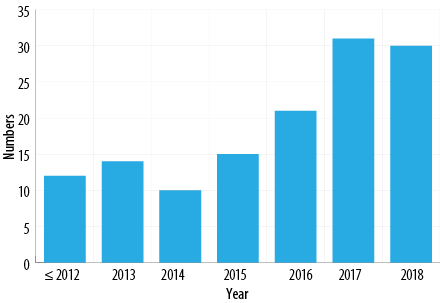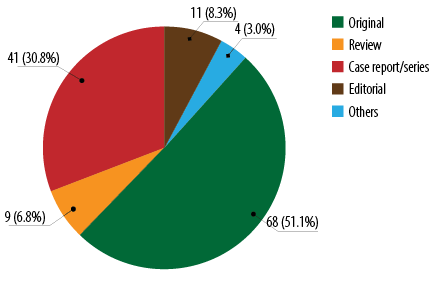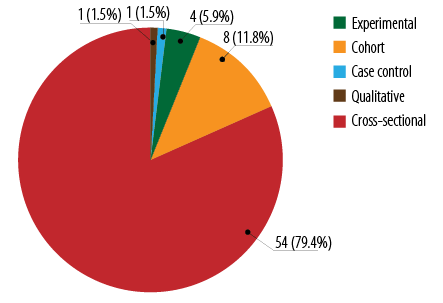Health research aims to prevent, diagnose, and cure illness. In addition, it attempts to improve health care systems to serve individuals and the communities better.1 Health-related research includes many types of studies, mainly basic, epidemiologic/public health, diagnostic, therapeutic and prognostic studies, and medical education and health system researchs.2
Globally, there is a big gap in research output between developed and developing countries, including the Arab region.3 This may be attributed to political instability and conflicts in the region.4–6 In addition, lack of freedom, democracy and funding, as well as brain drain are all important factors for the low performance of biomedical research in the Arab world.7
Oman is a developing Arab country in the Middle East and a member state of the Gulf Cooperation Council countries. It has been observed that the absolute number of publications per capita (based on the population) from Oman is still low.8 In general, local data showed an overall increase in the number of publications originating from Oman over the past years.9 However, the same data showed that the quality of research did not improve. In addition, more than a quarter of the biomedical publications from 2005−2009 appeared in journals having no impact factor (IF), and more than half of the publications were in journals having an IF < 1.9 Furthermore, research in Oman is mainly conducted by public institutions, and there is hardly any contribution from private institutions.9
Research training is an essential part of medical education to promote strong research culture and output in any medical community. Research training improves critical thinking and reasoning skills to develop a positive attitude among resident physicians during their medical careers. The Oman Medical Specialty Board (OMSB) was established in 2006. It is an Accreditation Council for Graduate Medical Education (ACGME)-International accredited national sponsoring institution that oversees graduate medical education in the country. It is the only postgraduate institution offering residency training in various clinical specialties in Oman.10 Currently, 518 residents in different year levels are involved in 18 medical and surgical residency training programs with minimum and maximum training periods of four and six years, respectively.10,11 Residents are trained mainly in five main tertiary institutions, including the Royal Hospital, the Sultan Qaboos University Hospital, Khoula Hospital, Al Nahdha Hospital, and the Armed Forces Hospital. In addition, some primary care centers are also involved in training family medicine residents.10
As the OMSB follows the ACGME, it takes the responsibility of advancing residents’ knowledge of the basic principles of research.12 Since established, the OMSB has emphasized research training and involvement of residents in research conduction under trainers’ supervision. In 2012, conducting at least one complete research project became a mandatory component of training requirements.13 Publishing the study in a peer-reviewed journal is encouraged by OMSB, but not as more mandatory as recent.13 In addition, research scholar activities are encouraged among trainers, and research publication became part of their career pathway.14 To date, the quantity and quality of research publications conducted within OMSB (among trainees and trainers) has not been fully explored. A single study only could be retrieved focusing merely on residents’ publications, which showed a very low publication rate.15 This study aims to review the research publication status of the OMSB with regard to quantity and quality aspects.
Methods
We retrieved data regarding the OMSB affiliated publications from four main databases: PubMed, Scopus, Web of Science, and Google Scholar. In PubMed, Scopus, and Web of Science, we used the affiliation to retrieve all publications. With the following Keywords ‘Oman medical specialty board’, ‘Oman medical speciality board’, and ‘OMSB’. For the Google Scholar, we used alternative combinations of the following keywords; ‘study’, ‘Oman’, ‘Oman Medical Specialty Board’, ‘Royal Hospital’, ‘Sultan Qaboos University Hospital’, Khoula Hospital’, ‘Al Nahdha Hospital’, ‘Armed Forces Hospital’, ‘primary care’, and ‘health center’. All relevant retrievals were skimmed for authors’ affiliations. Any publication with an author(s) suspected to be an OMSB resident or trainer but without affiliating OMSB were excluded. This is because it is difficult to judge whether such a study was conducted in the context of the OMSB work or the original institution’s work. The search was conducted in March 2019. All relevant publications until 31 December 2018 were included. Publications authored by at least one resident or trainer affiliated with the OMSB and publications with collaborations with other institutions where an OMSB affiliated author was involved were included as well. Data regarding journal IF, year of publication, type of publication, and study design were collected. Journal impact was assessed using the Clarivate (Thomson Reuter) IF and Scimago Journal and Country Rank (SJR) databases.16,17 In addition, the H-index of journals was traced from Scimago database.16 In both databases, the most recent (2017) impact data was described despite the publication year. All data was entered and analyzed using Microsoft Excel 2016. Duplications were removed before analysis.

Figure 1: Number of Oman Medical Specialty Board affiliated publications according to the year
of publication.

Figure 2: Frequency of Oman Medical Specialty Board affiliated publications according to publication type.

Figure 3: Frequency of original study publications according to study design.
Table 1: Details about indexing and impact of the publishing journals.
|
Local journals |
3 |
|
International journals |
46 |
|
Number of journals indexed in Clarivate (Thomson Reuters) |
22 |
|
Number of journals indexed in Scimago |
42 |
|
Number of journals not indexed in both Clarivate and Scimago |
7 |
|
Clarivate (Thomson Reuters) Impact Factor (min–max) |
0.82–15.13 |
|
Scimago Journal Rank (min–max) |
0.10–6.43 |
Results
A total of 133 published articles were retrieved, each has at least one author affiliated to OMSB were retrieved. Most of the articles (n = 121) were published after 2012. No article was published before 2004. The number of publications has increased over the years. Frequency of publications per year is given in Figure 1.
As for the type of publications, around half (51.1%) of the published papers were original studies, followed by case reports (30.8%) [Figure 2]. Reviews and editorials constituted 6.8% and 8.3%, respectively. The remaining 3.0% included letter to the editor, clinical quizzes, and comments.
Original studies differed significantly according to the study design used: 79.4% were cross-sectional studies, 11.8% cohort studies, and 5.9% experimental studies [Figure 3]. Furthermore, 50.0% (n = 34) of the original studies were retrospective in nature; among them, 20 (58.8%) were questionnaire-based surveys.
Most (61.0%) of the papers were published in three local journals, and the remaining in 46 international journals. Out of the 49 journals, around 44.9% are only indexed by the Clarivate (Thomson Reuters) database. Most (85.7%) of the total journals are indexed by the Scimago database. However, seven journals are not indexed by both databases. Only one journal had a very high Clarivate IF of 15.10, and the remaining ranged between 0.82 and 4.40. According to the Scimago database, the SJR ranged between 0.10 and 6.43, and the H-index ranged between 0 and 410. Table 1 presents details about the publishing journals.
Discussion
This study has reviewed the OMSB publication status in the past years. The number of publications is low compared to the total number of trainers and residents who are/were involved in the OMSB training programs. The number of original studies equals non-original studies. In addition, most original studies were cross-sectional and retrospective. Most of the publications were published in local journals, and most of the involved journals have no or a very low IF.
As the OMSB is a new growing postgraduate institution in a developing country, the number of related publications is expected to be suboptimal. The increase in publications after 2012 is expected, however, the overall output is unexpectedly very low compared to the total number of residents and trainers who are/were involved in the residency training programs. The low trend of residents’ publication was also observed in a recent study that was conducted among residents alone.15 As conducting a complete research project under the supervision of a mentor became mandatory for completing OMSB training in 2012, the number of OMSB publications is expected to be higher than the observed. Between 2013 and 2018, 543 residents graduated from the OMSB. However, until now, it is not mandatory for graduating residents to publish or submit their research for publication;13 a potential explanation for the very low number. In addition, training on manuscript writing is still lagging in OMSB, another reason for the low output.
The residency programs should find new ways to encourage residents to actively participate in research scholarly activities. They can consider providing residents with financial and non-financial incentives for presenting/publishing their research.18 In addition, making dissemination of research findings in a peer-reviewed journal and/or conference presentation a requirement for completion of the research blocks.19
OMSB publications were dominated by original studies and case reports which is promising. However, review articles were less than expected since they are as important as original studies and are relatively easier to be executed.20 Although the original studies dominated the publications, most were cross-sectional which has lower validity in the hierarchy of evidence. In addition, most were retrospective or questionnaire-based studies. This may be explained by the ease of conducting such studies, including that they take less time to conduct, as well as by the modest developing research culture among OMSB faculty and residents.
It seems that there is difficulty for the OMSB faculty and residents to publish in international journals since most studies were published in local journals. In addition, most journals had a low IF. This may emphasize the need for training in manuscript writing and publication skills. Increasing the quality of studies through a wider scope of training and strengthening the research culture is an inevitable solution.
This study has limitations. Firstly, we only searched four databases. Secondly, searching by affiliation in the PubMed-Medline records, for articles published before 2014 retrieves only the first author affiliation for some publishers.21 However, this problem was overcome partially by searching the other included databases. In addition, after 2014, papers with any author affiliated to the OMSB were searchable in PubMed, reducing the possibility of non-retrieval. Moreover, the low number of retrieved papers may be because the OMSB faculty and residents were affiliated with their main institutions. In this context, the OMSB has to emphasize its affiliation to all faculty and residents when publishing.
Conclusion
This is the first review of the status of the OMSB publications since its inspection. The publication output of the OMSB is still low. Most publications were published in local journals, and most of the involved journals had no or a very low IF. However, as this institution is a new growing institution, the future is promising. Although training is the key to strengthen the culture, training policies seem to have a bigger role in improving the status.
Disclosure
The authors declared no conflicts of interest. No funding was received for this study.
references
- 1. Bowling A. Research methods in health: investigating health and health services. 4th ed. McGraw Hill Education (UK): Open University Press; 2014.
- 2. Röhrig B, du Prel J-B, Wachtlin D, Blettner M. Types of study in medical research: part 3 of a series on evaluation of scientific publications. Dtsch Arztebl Int 2009 Apr;106(15):262-268.
- 3. Patel V, Kim Y-R. Contribution of low- and middle-income countries to research published in leading general psychiatry journals, 2002-2004. Br J Psychiatry 2007 Jan;190:77-78.
- 4. Arab human development report 2009. 2019 [cited 2019 March 24]. Available from: https://www.undp.org/content/undp/en/home/librarypage/hdr/arab_human_developmentreport2009.html.
- 5. Fergany N. Islam and science: steps towards reform. Nature 2006 Nov;444(7115):33-34.
- 6. Tadmouri GO, Bissar-Tadmouri N. Biomedical publications in an unstable region: the Arab world, 1988-2002. Lancet 2003 Nov;362(9397):1766.
- 7. Benamer HT, Bakoush O. Arab nations lagging behind other Middle Eastern countries in biomedical research: a comparative study. BMC Med Res Methodol 2009 Apr;9(1):26.
- 8. Al Mawali AH, Al Qasmi AM, Al Sabahi SM, Idikula J, Elaty MA, Morsi M, et al. Oman vision 2050 for health research: a strategic plan for the future based on the past and present experience. Oman Med J 2017 Mar;32(2):
86-96.
- 9. Rohra DK, Azam SI. Quantitative and qualitative analysis of PubMed-indexed biomedical publications in Oman from years 2005-2009. Oman Med J 2011 May;26(3):
160-165.
- 10. Oman Medical Specialty Board. Resident Manual. 2010.
- 11. Follow-up Section, Department of Trainee Affairs, Oman Medical Specialty Board. 2019.
- 12. Accreditation council for graduate medical education. Common program requirements. 2016 [cited 2019 December 2]. https://www.acgme.org/What-We-Do/Accreditation/Common-Program-Requirements.
- 13. Oman Medical Specialty Board. Resident, trainer and program assessment and evaluation handbook. 2015 [cited 2019 December 7]. Available from: http://www.omsb.org/File_Publications/Assessment%20Booklet%20August%2010%202015%20edited%2022%20September%202015.pdf.
- 14. Ministry of Health. Regulation by law for the medical and paramedical careers in public medical institutions (Civil and Military), Oman. Ministry of Health; 2014.
- 15. Al-Busaidi IS, Al-Shaqsi SZ, Al-Alawi AK, Al-Sinani S, Al-Kashmiri A. Characteristics, trends, and factors associated with publication among residents of Oman Medical Specialty Board programs. J Grad Med Educ 2019 Aug;11(4)(Suppl):104-109.
- 16. Scimago journal & country rank. [cited 2019 December 2]. Available from: https://www.scimagojr.com/.
- 17. Home - Clarivate analytics. [cited 2019 December 2]. Available from: https://clarivate.com/.
- 18. Chang CW, Mills JC. Effects of a reward system on resident research productivity. JAMA Otolaryngol Head Neck Surg 2013 Dec;139(12):1285-1290.
- 19. Papasavas P, Filippa D, Reilly P, Chandawarkar R, Kirton O. Effect of a mandatory research requirement on categorical resident academic productivity in a university-based general surgery residency. J Surg Educ 2013 Nov-Dec;70(6):715-719.
- 20. Carlson MD, Morrison RS. Study design, precision, and validity in observational studies. J Palliat Med 2009 Jan;12(1):77-82.
- 21. MEDLINE®/PubMed® data element (field) descriptions. [cited 2019 December 2]. Available from: https://www.nlm.nih.gov/bsd/mms/medlineelements.html.